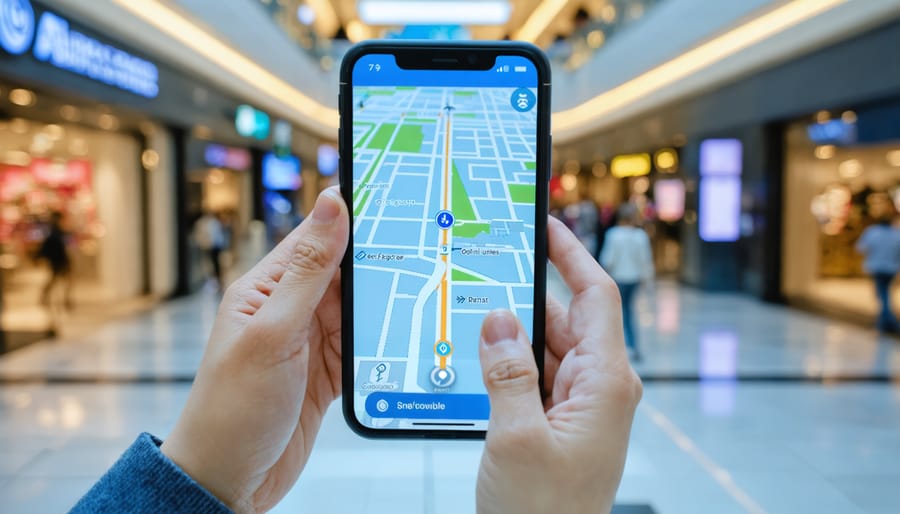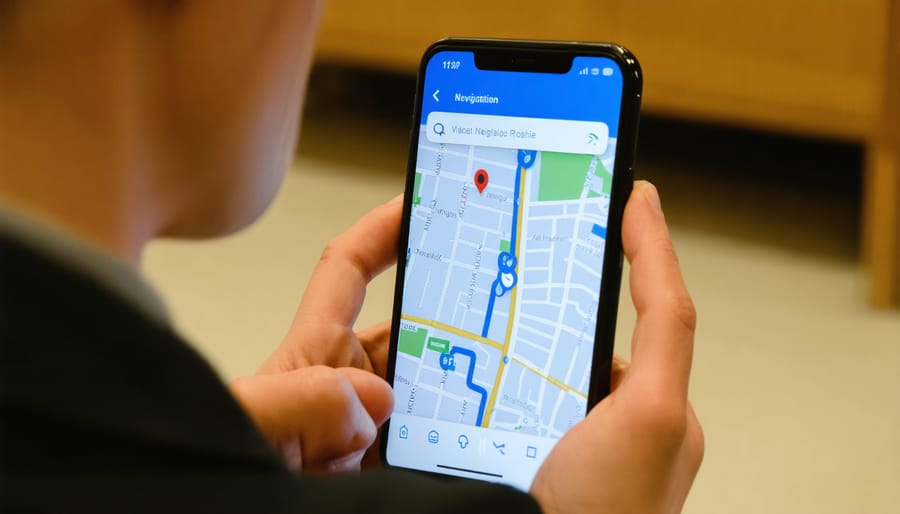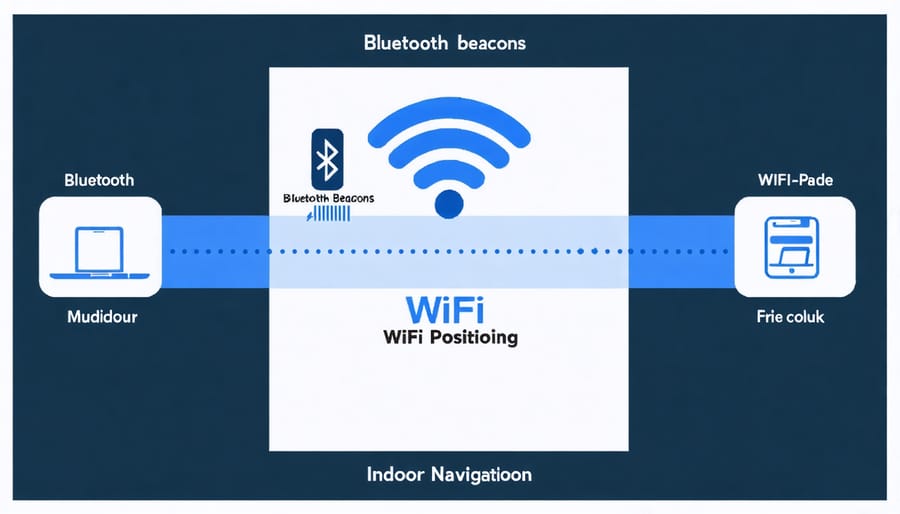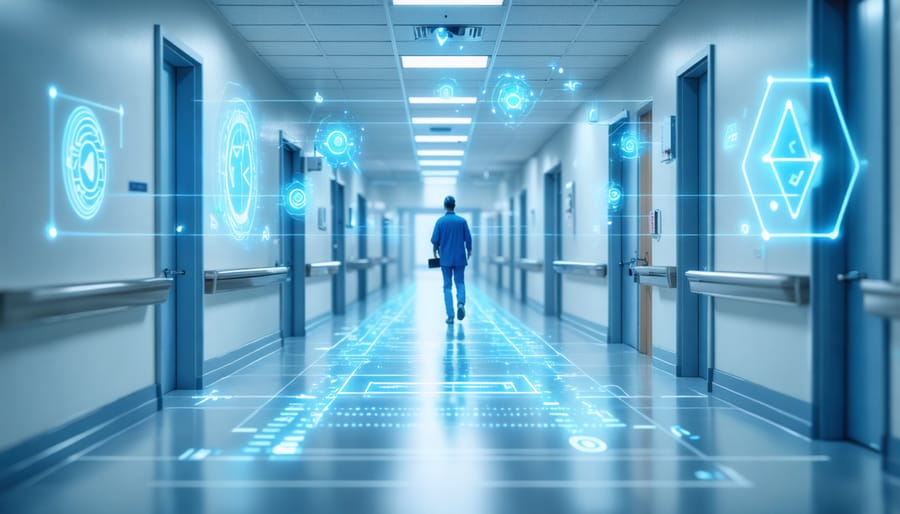
Revolutionizing indoor mobility, modern navigation applications are transforming how people move through complex buildings, malls, and airports with unprecedented precision and independence. These innovative systems combine smartphone sensors, Bluetooth beacons, and artificial intelligence to create detailed indoor maps and real-time positioning – delivering turn-by-turn directions with accuracy down to 1-2 meters. For visually impaired individuals and property managers alike, this technology marks a dramatic shift from traditional wayfinding methods, offering voice-guided navigation, obstacle alerts, and seamless transitions between outdoor GPS and indoor positioning systems.
The impact extends far beyond basic directions – these applications enhance safety protocols, optimize facility management, and provide valuable analytics about foot traffic patterns and space utilization. Property owners implementing indoor navigation solutions report increased visitor satisfaction, reduced congestion in high-traffic areas, and improved emergency response capabilities. With the global indoor positioning market projected to reach $23.6 billion by 2025, businesses investing in this technology position themselves at the forefront of accessibility innovation and customer service excellence.
This blend of cutting-edge technology and practical accessibility solutions creates more inclusive spaces while delivering measurable business benefits – making indoor navigation applications an essential consideration for modern property management.

Modern indoor navigation systems incorporate several essential features that make them invaluable for users with visual impairments while complementing existing smart lighting solutions in commercial and residential spaces. Real-time location tracking serves as the foundation, utilizing a combination of Bluetooth beacons, Wi-Fi positioning, and smartphone sensors to pinpoint a user’s exact position within a building.
Voice guidance provides clear, natural-language directions through high-quality text-to-speech technology, offering turn-by-turn navigation that adapts to the user’s pace and location. The system delivers contextual information about nearby points of interest, helping users maintain spatial awareness and make informed decisions about their route.
Advanced obstacle detection features use a combination of sensors and cameras to identify both static and moving obstacles in real-time. This technology can detect temporary barriers, construction areas, or crowded spaces, automatically suggesting alternative routes when necessary. The system also recognizes doors, elevators, and stairs, providing specific instructions for navigating these common building features.
Customizable settings allow users to adjust voice volume, speaking rate, and detail level of instructions based on their preferences and familiarity with the space. Emergency features include quick-exit routing and direct connection to building security or assistance services when needed.
Integration capabilities enable the system to work seamlessly with existing building management systems, ensuring that navigation instructions reflect current conditions such as temporary closures or maintenance work. This creates a comprehensive solution that enhances safety and independence for users while maintaining building security protocols.
Indoor navigation applications rely on a sophisticated combination of technologies working seamlessly together to provide accurate positioning and guidance. At the core of these systems are Bluetooth Low Energy (BLE) beacons, small wireless transmitters strategically placed throughout buildings. These beacons communicate with smartphones to determine user location with precision down to 1-2 meters.
WiFi positioning serves as a complementary technology, utilizing existing wireless networks to triangulate user position based on signal strength from multiple access points. This approach is particularly effective in buildings already equipped with extensive WiFi coverage, making implementation more cost-effective.
Modern smartphones contribute significantly through their built-in sensors, including accelerometers, gyroscopes, and magnetometers. These sensors work together to detect movement, orientation, and direction, enhancing navigation accuracy when combined with tactile surface design elements.
The magic happens when these technologies integrate through sophisticated algorithms. Machine learning processes continuously improve accuracy by analyzing movement patterns and environmental data. For example, when a user approaches a junction, the system combines beacon signals with smartphone sensor data to determine exact positioning and provide timely directional guidance.
Real-time updates ensure the system adapts to changes in the environment, such as temporary obstacles or route modifications. This dynamic approach makes indoor navigation particularly valuable in complex buildings like shopping malls, hospitals, and office complexes, where traditional wayfinding methods may fall short.

Indoor navigation applications have revolutionized how visually impaired individuals interact with complex retail environments, offering independence and confidence while shopping. These innovative systems, which often integrate with smart digital controls, provide turn-by-turn directions and real-time location information through smartphones or specialized devices.
Modern shopping centers are incorporating beacon technology and precision mapping to create detailed indoor navigation systems. These solutions help users locate specific stores, navigate through crowded corridors, and find essential amenities like restrooms or customer service desks. Voice-guided instructions offer clear, concise directions while avoiding obstacles and identifying landmarks along the way.
The technology also assists in product location within stores, helping users navigate different departments and locate specific items on shelves. Some advanced systems even integrate with store inventory databases, allowing users to create shopping lists and receive guided routes to their desired products.
Major retailers are increasingly adopting these solutions to enhance accessibility and provide a more inclusive shopping experience. The systems can be customized to account for temporary obstacles, store layout changes, and peak shopping hours, ensuring reliable navigation assistance throughout the day. This technology not only promotes independence but also helps businesses comply with accessibility standards while creating a more welcoming environment for all customers.

Healthcare facilities have emerged as prime beneficiaries of indoor navigation applications, transforming the way patients, visitors, and staff navigate complex medical environments. Major hospitals like Mayo Clinic and Cleveland Clinic have implemented these systems to significantly reduce missed appointments and improve patient experience.
These smart navigation solutions help guide patients directly to their designated departments, examination rooms, or diagnostic centers through their smartphones. For instance, Boston Children’s Hospital reported a 30% reduction in late arrivals after implementing their custom navigation app, which provides turn-by-turn directions through their 12-story facility.
Medical staff also benefit from these systems, particularly in emergency situations. Nurses and doctors can quickly locate vital equipment, such as crash carts or portable X-ray machines, saving precious minutes when time is critical. The University of California San Francisco Medical Center uses beacon-based navigation to help staff locate mobile medical assets across their 1.5 million square feet campus.
Beyond basic wayfinding, these applications integrate with hospital management systems to provide real-time updates on wait times, appointment schedules, and facility occupancy. Some advanced systems even allow patients to check in automatically when they arrive at specific departments, streamlining administrative processes.
For visitors, especially those dealing with stress or anxiety, these navigation tools provide peace of mind and independence when visiting loved ones, eliminating the need to repeatedly ask for directions or rely on often-confusing signage.
Implementing indoor navigation systems offers property managers and business owners significant advantages in creating more efficient, user-friendly spaces. By integrating these accessible design solutions, commercial properties become more welcoming to all visitors while increasing operational efficiency.
One of the primary benefits is enhanced customer satisfaction. Visitors can easily locate specific stores, offices, or amenities within large complexes, reducing frustration and improving their overall experience. This improved navigation experience often translates into longer visitor stays and increased customer spending.
For retail environments, indoor navigation systems provide valuable data analytics about customer movement patterns and preferences. Property managers can analyze foot traffic flow, identify high-traffic areas, and optimize space utilization accordingly. This information helps make informed decisions about store placement, advertising locations, and facility layout improvements.
The technology also streamlines maintenance and security operations. Staff can quickly respond to incidents or maintenance issues using precise location data, improving response times and resource allocation. During emergencies, these systems facilitate more effective evacuation procedures and help first responders navigate complex building layouts.
From a business perspective, indoor navigation applications create new marketing opportunities. Property managers can implement location-based promotional messaging, sending targeted offers to visitors as they pass specific areas. This capability enhances tenant businesses’ marketing efforts while providing additional revenue streams for property owners.
The system also demonstrates a commitment to accessibility, potentially increasing property value and attracting high-quality tenants. Modern businesses increasingly seek spaces that offer technological amenities and support diverse visitor needs, making indoor navigation systems a valuable investment in future-proofing commercial properties.
For facilities managing high visitor volumes, such as hospitals, shopping centers, or corporate campuses, these systems significantly reduce staff time spent providing directions, allowing them to focus on more valuable tasks. This efficiency improvement leads to measurable cost savings and improved operational effectiveness.
Indoor navigation applications have revolutionized how we interact with complex indoor spaces, making buildings more accessible and user-friendly for everyone. These technologies continue to evolve, incorporating advanced features like augmented reality, artificial intelligence, and improved accuracy through sensor fusion. As smart buildings become increasingly common, indoor navigation apps are poised to become an integral part of our daily lives, from shopping experiences to healthcare facilities. The future holds promising developments in personalized navigation, seamless indoor-outdoor transitions, and enhanced accessibility features for users with disabilities. With ongoing advancements in technology and growing adoption across industries, indoor navigation applications will continue to transform how we navigate and experience indoor spaces, creating more inclusive and efficient environments for all users.